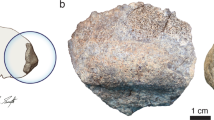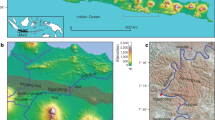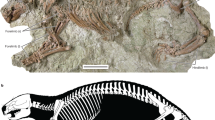Abstract
The discovery of Australopithecus anamensis fossils1 from strata lying between tephra dated at 4.17 and 4.12 million years ago, and from slightly higher strata not well constrained in age by overlying dated units, provoked the claim that more than one species might be represented: it was suggested that the stratigraphically higher fossils, which include the important tibia, humerus and a large, presumed male, mandible (KNM-KP 29287), might belong to a later, more derived hominid2. We have recovered new fossils from Kanapoi and Allia Bay, Kenya, during field work in 1995–1997 that confirm the primitive status of Australopithecus anamensis, the earliest species of Australopithecus. Isotope dating confirms A.anamensis' intermediate age as being between those of Ardipithecus ramidus3,4 and Australopithecus afarensis5,6. New specimens of maxilla, mandible and capitate show that this species is demonstrably more primitive than A. afarensis. A lower first deciduous molar (dm1) is intermediate in morphology between that reported for Ardipithecus ramidus4 and A.afarensis7. Single-crystal 40Ar–39Ar age determinations on the Kanapoi Tuff show that, except for a large mandible, all of the hominid fossils from Kanapoi are from sediments deposited between 4.17 ± 0.03 and 4.07 ± 0.02 million years ago.
This is a preview of subscription content, access via your institution
Access options
Subscribe to this journal
Receive 51 print issues and online access
$199.00 per year
only $3.90 per issue
Buy this article
- Purchase on Springer Link
- Instant access to full article PDF
Prices may be subject to local taxes which are calculated during checkout



Similar content being viewed by others
References
Leakey, M. G., Feibel, C. S., McDougall, I. & Walker, A. New four million-year-old hominid species from Kanapoi and Allia Bay, Kenya. Nature 376, 565–571 (1995).
Andrews, P. Paleontology—Ecological apes and ancestors. Nature 376, 555–556 (1995).
White, T. D., Suwa, G. & Asfaw, B. Australopithecus ramidus, a new species of early hominid from Aramis, Ethiopia. Nature 371, 306–312 (1994).
White, T. D., Suwa, G. & Asfaw, B. Corrigendum: Australopithecus ramidus, a new species of early hominid from Aramis, Ethiopia. Nature 375, 88 (1995).
Johanson, D. C. & White, T. D. Asystematic assessment of early African hominids. Science 202, 321–330 (1979).
Kimbel, W. H., Johanson, D. C. & Rak, Y. The first skull and other new discoveries of Australopithecus afarensis at Hadar, Ethiopia. Nature 368, 449–451 (1994).
Johanson, D. C., White, T. T. & Coppens, Y. Dental remains from the Hadar Formation, Ethiopia: 1974–1977 collections. Am. J. phys. Anthrop. 57. 545–603 (1982).
Brown, F. H. & Feibel, C. S. Stratigraphy, depositional environments and palaeogeography of the Koobi Fora Formation.in Koobi Fora Research Project Vol. 3(ed. Harris, J. M.) 1–30 (Clarendon, Oxford, (1991).
Powers, D. W. Geology of Miocene Sediments of the Lower Kerio Valley, Kenya(Thesis, Univ. Princeton, (1980).
Haileab, B. Geochemistry, Geochronology and Tephrostratigraphy of Tephra from the Turkana Basin, Southern Ethiopia and Northern Kenya(Thesis, Univ. Utah, (1995).
Bush, M. E., Lovejoy, C. O., Johanson, D. C. & Coppens, Y. Hominid carpal, metacarpal, and phalangeal bones recovered from the Hadar Formation: 1974–1977 collections. Am. J. phys. Anthrop. 57, 651–677 (1982).
Robinson, J. T. Early Hominid Posture and Locomotion(University of Chicago Press, Chicago, (1972).
Gould, S. J. Unusual unity. Nat. Hist. 106, 20–23 and 69–70 (1997).
Cebula, G. T. et al. The Fish Canyon Tuff, a potential standard for the 40Ar/39Ar and fission track dating methods.(Abstract) Terra Cognita 6, 139–140 (1986).
McDougall, I. & Harrison, T. M. Geochronology and Thermochronology by the 40Ar/39Ar Method(Oxford Univ. Press, New York, (1988).
Acknowledgements
We thank the Government of Kenya for permission to carry out this research and the National Museum of Kenya for logistical support. The National Geographic Society funded the field work; the National Science Foundation and the Leakey Foundation awarded grants to C.F. and A.W. Neutron irradiations were facilitated by the Australian Institute of Nuclear Science and Engineering and the Australian Nuclear Science and Technology Organization. We thank Caltex (Kenya) for fuel and Rover Group and the NGS for vehicles, and T. White and F. Spoor for their help. The expedition included K.Cheboi, S. Dominic, G. Ekalale, M. Eregae, J. Erus, N. Ewalan, J. Kaatho, C. Kiarie, K. Kimeu, F. Kyalo, M. Kyeva, B. Kyongo, L. Leakey, N. Lowis, S. Makathimo, B. Malika, W. Mangao, S. Milledge, L. Moru, M.Muoka, J. Mutaba, D. Mutinda, N. Mutiwa, S. Ngui, B. Onyango and J. Wynn; S. Hagemann and L.Hlusko assisted at Allia Bay; J. Mya undertook the mineral separations; R. Maier assisted with handling of samples for irradiation; and A. Ibui, F. Kyalo, E. Mbua, M. Muungu and A. Mwai provided curatorial assistance.
Author information
Authors and Affiliations
Corresponding author
Rights and permissions
About this article
Cite this article
Leakey, M., Feibel, C., McDougall, I. et al. New specimens and confirmation of an early age for Australopithecus anamensis. Nature 393, 62–66 (1998). https://doi.org/10.1038/29972
Received:
Accepted:
Issue Date:
DOI: https://doi.org/10.1038/29972
This article is cited by
-
Early Pleistocene cut marked hominin fossil from Koobi Fora, Kenya
Scientific Reports (2023)
-
A genotype:phenotype approach to testing taxonomic hypotheses in hominids
The Science of Nature (2020)
-
Age and context of mid-Pliocene hominin cranium from Woranso-Mille, Ethiopia
Nature (2019)
Comments
By submitting a comment you agree to abide by our Terms and Community Guidelines. If you find something abusive or that does not comply with our terms or guidelines please flag it as inappropriate.



